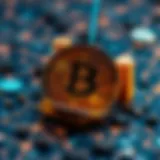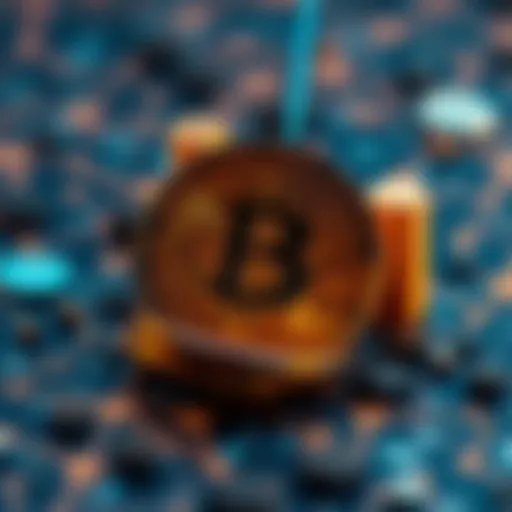NFT Mania: Understanding the Surge of Non-Fungible Tokens


Intro
The surge of Non-Fungible Tokens (NFTs) in recent years has prompted a whirlwind of discussion among investors, creators, and the tech-savvy. Gone are the days when the term ‘digital asset’ was a mere afterthought. Now, NFTs have carved out a unique space in the vast world of cryptocurrency and digital art, reshaping how we perceive ownership and value in the digital realm.
Unlike traditional cryptocurrencies such as Bitcoin or Ethereum, which are fungible and can be exchanged on equal terms, NFTs are one-of-a-kind entities, imbuing digital assets with unique properties that cannot be replaced or exchanged on a one-to-one basis. This singular characteristic has spurred an unprecedented growth in interest. Artworks, music, virtual goods, and even tweets have been sold as NFTs, turning them into collectible treasures that signal status and investment potential.
In this article, we will navigate the intricate landscape of NFTs, peeling back the layers of their technological foundations and cultural ramifications. We will explore the factors driving their popularity, various sectors they touch, and the potential pitfalls that investors face. Furthermore, we will delve into market analysis and investment strategies to provide a holistic view of this phenomenon.
Let’s embark on this journey to uncover why NFTs have captured the imagination of many and what they might mean for the future.
Market Analysis
As the NFT market continues to expand, it’s essential to understand the current landscape and where it may head in the future. Investors keen on leveraging the trends in this space need a pulse on market dynamics.
Current Trends in Cryptocurrency
Cryptocurrency has been on a roller coaster ride, significantly impacting the NFT market as well. There’s a correlation between the price movements of cryptocurrencies and the NFT market. When Bitcoin rises, so does interest in NFTs. It seems a majority of NFT transactions are funded with Ethereum, meaning fluctuations in Ethereum’s price can directly affect NFT prices and sales volumes.
With marketplaces like OpenSea and Rarible leading the charge, we see that the demand for NFTs is swelling, fueled by innovative projects and celebrity endorsements. The rise of institutional investments into cryptocurrency has also paved the way for NFTs to gain legitimacy and traction among traditional investors.
- Key trends include:
- Increased adoption of NFTs in gaming, allowing players to own in-game assets.
- The emergence of metaverse platforms incorporating NFTs for virtual real estate.
- Traditional artists tapping into the NFT ecosystem to monetize their work and reach global audiences.
Price Prediction Techniques
When trying to forecast the future value of NFTs, one must navigate a complex set of variables. It’s not as straightforward as analyzing stock trends. Rather, factors like provenance, community support, and scarcity come into play.
"Pricing NFTs is akin to piecing together a puzzle; every piece tells a part of the story."
Tools like Dune Analytics can help investors track sales volumes and average transaction prices across various marketplaces. Many experts suggest taking a hybrid approach, assessing both the emotional and intrinsic value of an NFT, instead of merely relying on historical price data.
Investors may find trend analysis, including community engagement and creator reputation, beneficial to their decision-making process. Moreover, monitoring drops and minting events can serve as an early indicator of rising stars in the NFT world.
With these insights, investors can better position themselves in this dynamic marketplace, grasp the nuances behind valuations, and perhaps strike gold in a landscape that’s as thrilling as it is uncharted.
The Concept of NFTs
Understanding the concept of Non-Fungible Tokens (NFTs) is crucial as they form the backbone of a digital revolution that is transforming various sectors. NFTs stand not just as a trend but rather as a significant development in how we perceive ownership, value, and authenticity in the digital landscape. This section dives into the fundamental aspects of NFTs, highlighting their uniqueness and how they differ from traditional digital assets, which is valuable for investors, traders, analysts, and tech enthusiasts alike.
Definition and Characteristics
At its core, a Non-Fungible Token is a one-of-a-kind digital asset that exists on a blockchain, a decentralized digital ledger. Unlike cryptocurrencies such as Bitcoin or Ethereum, which are fungible and can be exchanged on a one-to-one basis, NFTs have distinct characteristics that set them apart. Each NFT has a unique identifier, which ensures their individuality. This uniqueness allows for the representation of ownership for digital items such as art, music, or virtual real estate.
Here are some key characteristics of NFTs:
- Indivisibility: Unlike cryptocurrencies, NFTs cannot be divided. You either own the whole token or you don’t.
- Ownership Verification: The blockchain serves as an immutable ledger, verifying ownership and previous transactions, boosting the authenticity of the asset.
- Interoperability: NFTs can exist across different platforms, making them versatile in how they can be used or showcased.
- Scarcity: NFT creators can impose limitations on how many copies of a particular digital item exist, creating a sense of rarity that appeals to collectors.


Understanding these characteristics allows stakeholders to grasp why NFTs have taken the digital world by storm. The potential for ownership and representation of digital assets presents opportunities that were unimaginable a few years back.
How NFTs Differ from Other Digital Assets
The distinction between NFTs and traditional digital assets lies primarily in fungibility and the notion of value assigned to digital ownership. In the world of cryptocurrencies, one Bitcoin can be swapped for another without losing value; it remains the same asset. NFTs, however, are sold based on their uniqueness and perceived value, much like a physical artwork.
Here is how NFTs stand out:
- Uniqueness: Every NFT is distinct and has specific metadata that sets it apart within the blockchain ecosystem. This quality makes them ideal for securing ownership of unique items such as collectibles or art.
- Ownership Rights: When you purchase an NFT, you buy a token that proves ownership of a digital item, whereas traditional digital assets do not provide such a clear ownership structure.
- Market Dynamics: The market for NFTs is highly variable, driven by demand, rarity, and cultural significance, which can lead to vastly different valuation processes compared to fungible assets.
"NFTs embody a fusion of art, technology, and economics, bringing a new framework for ownership that challenges our traditional conceptions of value."
As we dive deeper into the realm of NFTs, it becomes evident that their emergence is more than a mere fad. It represents a shift in the fabric of digital interaction, redefining how we engage with art, collectibles, and even virtual identities.
Technological Framework
The technological framework underlying Non-Fungible Tokens (NFTs) is as critical as the tokens themselves. This framework, particularly centered around blockchain technology, not only validates the ownership and uniqueness of each digital asset but also ensures security and transparency in transactions. Understanding this backbone is key to grasping how NFTs have emerged as a viable asset class, capturing the interests of forward-thinking investors and creators alike.
Blockchain Technology and NFTs
Blockchain technology serves as the foundation for NFTs. Think of it as a digital ledger that records all transactions across a network of computers. Every time an NFT is bought, sold, or transferred, the details are logged on this ledger, making it nearly impossible to alter past transactions without consensus from the network. This decentralized nature is what sets NFTs apart from other digital assets.
The transparency inherent in blockchain is also a strong selling point. Anyone can view the chain of ownership and transaction history, giving buyers confidence that their investment is legitimate. Furthermore, since blockchain operates on a peer-to-peer network, there's no central authority dictating the rules, which means that the power remains in the hands of creators and consumers alike.
"With blockchain, we saw the dawn of a new era—one where tech start-ups can thrive without the big players looming overhead."
Smart Contracts: The Backbone of NFTs
Smart contracts are another critical element of this technological framework. They are self-executing contracts with the terms of the agreement directly written into code. When certain conditions are met—such as the transfer of an NFT—the smart contract automatically executes. This ensures that the agreement is fulfilled without intervention from a third party.
The ability to customize smart contracts allows for unique functionalities such as royalty arrangements. For example, an artist might stipulate that they receive a percentage fee every time their NFT changes hands. This feature not only empowers creators but also provides a continuous income stream, enhancing the attractiveness of NFT investments.
Minting Process Explained
Minting is the process of creating an NFT, and it can seem daunting to those outside the space. Essentially, minting transforms a digital file into a part of the Ethereum blockchain—or, on occasion, other blockchains like Solana or Tezos. The metadata associated with the file, such as attributes, ownership details, and even the file's original creator, is encoded onto the blockchain.
Here's a simplified step-by-step breakdown of the minting process:
- Choose a Platform: Select an NFT marketplace, like OpenSea or Rarible, that supports the minting of NFTs.
- Connect a Wallet: You'll need a digital wallet, such as MetaMask, where you can hold your NFTs and cryptocurrencies.
- Create the NFT: Upload your digital file and input the necessary details like title, description, and any attributes you want to include.
- Mint the NFT: Once you confirm the details and proceed with minting, the file is converted into an NFT and stored in the blockchain.
- List for Sale: After minting, you have the option to list your NFT for sale, setting the price and choosing sale types such as auction or fixed price.
Understanding the minting process is crucial for creators looking to enter the NFT space. It’s not just about creating art or music; it’s about forming a secure, verifiable digital presence that can thrive in a competitive market.
The Cultural Shift Introduced by NFTs
The rise of Non-Fungible Tokens (NFTs) has not just altered the way digital assets are perceived; it has catalyzed a profound cultural shift across various domains. This section will explore how NFTs have redefined traditional paradigms — from the art world to gaming — and the implications that arise from these changes. Understanding this shift is crucial because it casts light on the evolving landscape where creativity meets technology. In this melting pot of innovation, we find that NFTs challenge long-held beliefs about ownership, value, and the role of the creator in the digital realm.
Impact on the Art World
The impact of NFTs on the art world has been nothing short of transformative. Artists who once faced barriers to entry can now sell their work directly to buyers without the need for galleries or intermediaries. This democratization of art sales erases geographical boundaries and empowers creators from all walks of life.


- New Revenue Streams: Unlike traditional art forms, NFTs allow artists to embed smart contracts that can ensure they receive a percentage of future sales. This means that if an artwork appreciates in value, the artist benefits long-term, which was largely unattainable via conventional sales.
- Ownership and Authenticity: With NFTs, ownership becomes verifiable thanks to blockchain technology, allowing collectors to own unique pieces indisputably. This authenticity is crucial in an era where digital art can be easily copied.
- Shifting Paradigms: Some experts argue that NFTs are reshaping what we consider "art." Works that may not fit into traditional categories now have a platform, challenging the established norms of both creation and consumption.
Art critic, Dr. Emily Carter, notes:
"Artists today are no longer just creators; they are also entrepreneurs navigating a new digital economy."
Influence on Gaming and Virtual Realities
Gaming is yet another arena where NFTs are causing a seismic shift. The introduction of NFTs has opened new doors in how games operate, paving the way for players to genuinely own in-game assets. This has implications that stretch well beyond simple gaming enjoyment.
- True Ownership: Players can now buy, sell, or trade their in-game items with actual financial value. Just as someone might trade a baseball card, gamers can trade skins, weapons, and other collectibles as NFTs.
- Play-to-Earn Models: These models have popped up, allowing players to earn tangible rewards through gameplay. Players are motivated not just by entertainment but by financial gain, effectively transforming their gaming experience into a source of income.
- Interoperability Across Platforms: NFTs enable items to be used across different games. A sword acquired in one game could be used in another, paving the way for a connected gaming universe.
Collectibles and Memorabilia in a Digital Age
Collectibles, whether they be sports cards or limited-edition toys, have found renewed life through NFTs. The digital format allows for easy verification and ownership, radically changing how we perceive and invest in collectibles.
- Verified Rarity: Just as physical collectibles are valued for their rarity, NFTs bring a new dimension to scarcity. A digital collectible can be one of a kind, and its ownership history is unalterable, enhancing its desirability among collectors.
- Accessibility: In the digital realm, collectibles can be made accessible to a wider audience. No longer do you need to be at a physical event or in a specific location; with just a few clicks, anyone can participate in the marketplace.
- New Market Behaviors: The ability to assign value to digital collectibles creates a new class of investors who are treating these assets with the same seriousness as traditional items. The blending of sentiment and finance has catalyzed a rise in community-driven marketplaces.
Through these lenses, it is evident that NFTs have brought about a cultural shift, reorienting our views on creativity, ownership, and the value we place on digital creations. The continuing evolution of NFTs promises to propel this shift even further, making it a focal point of interest for investors and creators alike.
Further Reading on the Impact of NFTs in Various Domains
More on NFTs and Digital Collectibles
Understanding Blockchain Technology
Economic Implications of NFTs
The rise of Non-Fungible Tokens has ushered in not just a cultural shift, but a significant economic one as well. In the face of traditional asset classes, NFTs challenge our understanding of ownership, value, and market mechanics. The economic implications are multi-faceted, spanning from market dynamics to the risks posed to investors, ultimately reflecting the broader transformation occurring in our digital landscape.
Market Dynamics and Trends
NFTs have disrupted conventional market dynamics, acting as both a novelty and a serious investment vehicle. The surge in digital artworks, collectible items, and even virtual real estate has altered how buyers and sellers interact. Recent data highlights that the NFT market had transactions worth billions, highlighting the growing interest.
Several trends are observable in this space:
- Increased Mainstream Adoption: Companies like Adidas and Time Magazine leveraging NFTs point to mainstream acceptance. When brands start creating their own NFTs, it speaks volumes about shifting market perceptions.
- Diverse Marketplace Growth: Platforms like OpenSea and Rarible foster a bustling ecosystem, giving creators and buyers multiple avenues for transactions. The competition among these platforms is leading to innovative features and more user-friendly interfaces.
In this shifting landscape, market demand fluctuates rapidly. Factors such as trending artists, viral social media moments, and even celebrity endorsements can lead to explosive price movements, which brings us to the next crucial aspect.
Investment Opportunities and Risks
When engaging with NFTs, investors find themselves straddling a tightrope — the allure of high returns versus existing risks. The optimistic view revolves around the idea that buying an NFT can yield significant profits, especially if the asset becomes highly sought after.
However, this is a double-edged sword.
- Price Volatility: The NFT market can be compared to a wild rollercoaster ride. Values can skyrocket, only to plummet just as fast. Investors need to be aware that what goes up doesn't always stay up, as many speculative buyers exited the market after an initial buzz.
- Liquidity Issues: While NFTs can fetch millions, finding a buyer at that price in a declining trend is another ballgame entirely. Unlike a stock that can be sold at market prices, NFTs might take longer to sell or potentially not sell at all.
- Due Diligence: Navigating NFTs demands thorough research. Knowing the provenance and authenticity of a digital asset is paramount for any serious investor.
The Role of Speculation in NFT Prices
Speculation sits at the heart of NFT price movements. Unlike tangible assets, NFTs are often valued based on perceived rarity, unique characteristics, or even social influence.
- Hype Culture: Community-driven excitement can inflate prices to unbelievable levels. Social media hype can create a frenzy, leading to bidding wars that seem to stem from sheer excitement rather than logical valuation. This can lead to prices becoming artificially inflated.
- Celebrity Influence: High-profile endorsements can drive prices to new heights. Think of how an artwork by Banksy could further be priced if a celebrity were to buy it; the narrative surrounding the transaction often amplifies its desirability.
- Investment vs. Collectibility: For many, the allure of NFTs stems less from investment and more from collectibility. Individuals are driven by a passion for art, gaming, or fandom, but that doesn't mean they are exempt from market dynamics; their perceived value can heavily influence investment decisions.


In summary, the economic implications of NFTs reflect a melting pot of innovation and uncertainty. While they present exciting opportunities, they also necessitate a clear understanding of the associated risks. As the market continues to evolve, keeping a keen eye on trends, investment risks, and the speculative nature of pricing will be crucial for anyone looking to engage with this transformative digital asset.
Legal and Regulatory Considerations
The landscape of Non-Fungible Tokens (NFTs) is rife with potential and uncertainty. As this digital asset class continues to expand, understanding the legal and regulatory aspects becomes paramount for creators, investors, and consumers alike. The unique properties of NFTs, combined with their increasing popularity, raise critical questions surrounding ownership, rights, and compliance that cannot be overlooked. Navigating these waters is essential to not only safeguard investments but also ensure that innovations remain within the boundaries of existing laws.
Intellectual Property Issues
One of the primary concerns in the realm of NFTs is intellectual property. Unlike traditional assets, the ownership of an NFT does not automatically impart rights to the underlying content, leading to a hazy legal situation. For instance, a buyer may acquire a digital artwork as an NFT but may not possess the copyright to the image. This distinction is crucial, as it shapes how creators can profit from their work.
It’s worth noting that agreements can vary significantly. Many artists include specific licenses when selling their NFTs, delineating the rights granted to the buyer. However, understanding these terms is vital. Artists need to be proactive about protecting their creations, while buyers must discern what they are truly purchasing. To navigate this complex interplay, legal advice is often essential, as even the most seasoned NFT enthusiasts can find it daunting.
Tax Implications of NFT Transactions
The tax implications surrounding NFT transactions present another layer of complexity. Many jurisdictions treat NFTs as property, which means that buying and selling them can trigger capital gains tax. When a collector sells an NFT for a profit, they may be responsible for reporting this income, leading to tax obligations that can catch them off guard.
It's crucial for NFT traders to maintain thorough records of their transactions, including purchase prices and sale prices. Notably, in the U.S., the Internal Revenue Service (IRS) has classified cryptocurrency transactions this way, and it's not unreasonable to expect a similar treatment for NFTs. Different countries have varying regulations regarding taxation, so investors should familiarize themselves with the specific rules that apply in their regions to avoid potential pitfalls.
Regulatory Landscape and Its Evolution
As the NFT market evolves, so does the regulatory landscape. Currently, many governments and regulatory bodies are still in the observation phase, trying to understand how to approach these emerging technologies. In some areas, there have already been calls for increased oversight, particularly concerning fraud and market manipulation. The decentralized nature of blockchain technology complicates enforcement but also opens discussions about creating a balanced regulatory framework that fosters innovation while protecting consumers.
The conversations around NFTs have sparked debates in legislative halls, bringing attention to their economic potential and the risks associated with fraud and theft. Multiple jurisdictions are considering formal regulations, leading to a patchwork of compliance requirements that vary widely from one locale to another. As regulatory clarity emerges, staying informed about changes will be essential for anyone involved in the NFT space.
Future Potential and Challenges
The future of Non-Fungible Tokens (NFTs) is a topic buzzing with excitement and uncertainty. As we delve into this section, we uncover not only the potential benefits of NFTs but also the complexities and challenges that loom on the horizon. The interest in NFTs is not just a fad; it represents a significant shift in how we perceive ownership, creativity, and investment in the digital age. However, several considerations must be addressed to unlock their true potential and sustainability.
Sustainability Concerns Surrounding NFTs
One cannot ignore the environmental impact that NFTs have garnered through various blockchain networks. The process of minting and trading NFTs often uses proof-of-work systems, which, truth be told, are energy-intensive and contribute to increasing carbon footprints. For instance, Ethereum, the predominant blockchain for NFT creation, has been scrutinized for its energy consumption. Recent studies estimate that a single Ethereum transaction could use the same amount of energy as an average household in a year.
Addressing these concerns, several platforms are shifting to more energy-efficient models. Newer blockchains like Tezos and Flow leverage proof-of-stake mechanisms, which consume significantly lower energy. Advocates argue that if this trend continues, NFTs can maintain their market growth while also becoming more environmentally friendly.
- Exploring Options for Greener Solutions: Brand new protocols are in development, aimed at reducing environmental effects.
- Adoption of Carbon Offsetting Techniques: Some NFT platforms are investing in sustainability projects to offset their environmental impacts.
Understanding these sustainability issues is crucial for investors and creators alike. As consciousness regarding climate change grows, the demand for greener NFTs could shape the landscape of the digital asset class.
Integration with Emerging Technologies
NFTs are developing rapidly, and their integration with emerging technologies like augmented reality (AR) and artificial intelligence (AI) holds a lot of promise. These technologies can enhance the functionality and appeal of NFTs in several ways. Imagine a virtual gallery, where users can interact with digital art through AR, or how AI can create dynamic NFT art that evolves over time, reflecting both the creator’s and the audience's engagement with it.
- Potential Uses in the Gaming Sector: Imagine NFTs representing unique in-game assets that can be used across platforms, thanks to compatibility with AR and VR.
- Interoperability Challenges: While this interplay seems exciting, it presents hurdles for developers who need to ensure seamless integration without compromising user security.
The continued synergy between NFTs and these technological advancements could redefine digital ownership and allow for immersive experiences previously deemed impossible.
Predictions for the NFT Market Landscape
The market for NFTs could undergo considerable transformation in coming years. Experts anticipate a more mature ecosystem driven by regulatory clarity and increased mainstream acceptance. An emerging trend could be the establishment of NFT standards that govern ownership and trade.
Investors should keep an eye out for the following:
- Growth in Corporate Involvement: Major brands and corporations are venturing into NFTs, suggesting that they are becoming a pivotal part of branding strategies.
- Enhanced Utility Beyond Collectibles: NFTs are expected to branch out from art and collectibles into sectors such as real estate and intellectual property, showcasing their vast applications.
- Market Consolidation: As with any burgeoning market, oversaturation could lead to consolidation scenarios. Companies that fail to innovate may fall by the wayside, while strong performers could merge or acquire to expand their influence.
The NFT landscape is ripe for change, and its future seems promising yet fraught with obstacles. Stakeholders, from creators to investors, should pay close attention to how these challenges and innovations unfold in the coming years. The decisions and strategies adopted today will determine the trajectory of NFTs in the long run.















